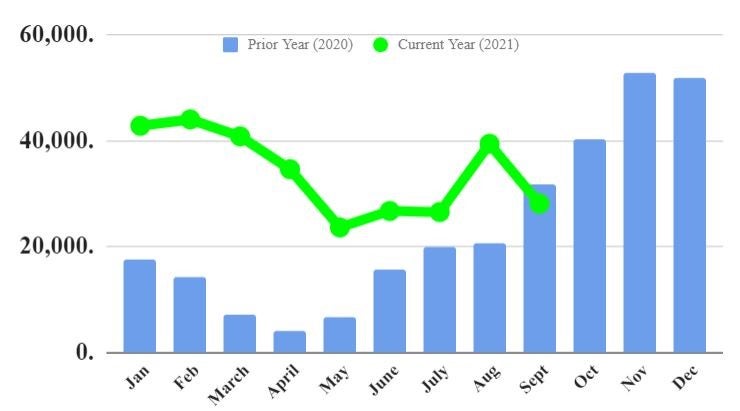Editor’s note: UPDATES with FTR commentary and chart
Class 8 truck orders typically rise in September as manufacturers open their order books. That is not happening this year.
The combination of the semiconductor shortage and shortfalls in as many as 40 other parts needed to assemble heavy-duty trucks led manufacturers to write far fewer orders in September than the typical first month of fall.
“This is a complicated, bizarre situation that OEMs have never before encountered,” said Don Ake, vice president of commercial vehicles at FTR Transportation Intelligence.. “There are many orders that were expected to be built in 2021 that cannot be completed due to the severe component shortages, most notedly, semiconductors.”
Demand for new trucks is high. Freight rates continue to be elevated. But manufacturers cannot keep up. Even trucks they assemble are being parked awaiting parts, a process called red-tagging. Paccar Inc. said late Monday Q3 deliveries of its Kenworth, Peterbilt and DAF Trucks will fall 7,000 units short of the previous quarter.

It’s a supply, not a demand problem
“It is important to note that it is not demand, but supply that is dictating new order activity, as OEMs are being judicious in fully opening 2022 order books when there is not clear visibility of supply-chain capacity next year,” said Kenny Vieth, president and senior analyst at ACT Research.
Preliminary North American Class 8 orders in September were 27,400 units, down from 36,900 bookings in August. FTR said 453,000 trucks have been ordered on a rolling 12-month basis. FTR pegged preliminary September orders at 28,100, down 12% year over year versus last September.
“September traditionally marks the transition from the annual summer order trough into fall peak order activity,” Vieth said.
“However, with demand indicators from freight activity to freight rates and carrier profits in blatant contrast to equipment shortages and capacity constraints across all transportation modes, it is understandable that September’s Classes 5-8 order volume could be construed as disappointing relative to the economic setup.”
Added Ake: “Unfortunately, the supply chain remains a huge mess. Parts and components are so constricted, as well as raw materials, it will take many months to rectify, and conditions are expected to improve gradually, over an extended period.”
Another factor suggesting an extended lull is recent reports of energy sector issues in China which, Vieth said, “dampen hope for the current supply situation to surprise on the high side in terms of recovery timing.”
Related articles:
Peak used truck prices persist as Class 8 production lags
August Class 8 truck bookings rise as manufacturers selectively accept orders
Holding pattern: July Class 8 truck orders hide underlying demand







